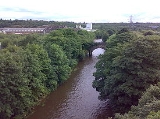
Clifton Aqueduct
Encyclopedia
Clifton Aqueduct
, built in 1796, carried the Manchester, Bolton and Bury Canal
across the River Irwell
in Salford
, England
. It is preserved as a Grade II listed building. The construction is of dressed stone with brick arches. Three segmental arches with keystones rest on triangular-ended cutwaters. Above the cutwaters are flat Pilaster
s. A C20 brick parapet
remains on the eastern side. There is a towpath on each side, and the aqueduct contains grooves for stop planks to be inserted, to drain the canal. The aqueduct was engineered by Charles Roberts and John Nightingale.
The aqueduct is one of two remaining along the canal route, the other being Prestolee Aqueduct
. The canal is currently undergoing restoration (at the time of writing, at the Salford end of the canal) and is hoped to be in operation around 2020.
As of 2011, the aqueduct is currently not in water.
Aqueduct
An aqueduct is a water supply or navigable channel constructed to convey water. In modern engineering, the term is used for any system of pipes, ditches, canals, tunnels, and other structures used for this purpose....
, built in 1796, carried the Manchester, Bolton and Bury Canal
Manchester, Bolton and Bury Canal
The Manchester Bolton & Bury Canal is a disused canal in Greater Manchester, England, built to link Bolton and Bury with Manchester. The canal, when fully opened, was 15 miles 1 furlong long. It was accessed via a junction with the River Irwell in Salford...
across the River Irwell
River Irwell
The River Irwell is a long river which flows through the Irwell Valley in the counties of Lancashire and Greater Manchester in North West England. The river's source is at Irwell Springs on Deerplay Moor, approximately north of Bacup, in the parish of Cliviger, Lancashire...
in Salford
City of Salford
The City of Salford is a city and metropolitan borough of Greater Manchester, England. It is named after its largest settlement, Salford, but covers a far larger area which includes the towns of Eccles, Swinton-Pendlebury, Walkden and Irlam which apart from Irlam each have a population of over...
, England
England
England is a country that is part of the United Kingdom. It shares land borders with Scotland to the north and Wales to the west; the Irish Sea is to the north west, the Celtic Sea to the south west, with the North Sea to the east and the English Channel to the south separating it from continental...
. It is preserved as a Grade II listed building. The construction is of dressed stone with brick arches. Three segmental arches with keystones rest on triangular-ended cutwaters. Above the cutwaters are flat Pilaster
Pilaster
A pilaster is a slightly-projecting column built into or applied to the face of a wall. Most commonly flattened or rectangular in form, pilasters can also take a half-round form or the shape of any type of column, including tortile....
s. A C20 brick parapet
Parapet
A parapet is a wall-like barrier at the edge of a roof, terrace, balcony or other structure. Where extending above a roof, it may simply be the portion of an exterior wall that continues above the line of the roof surface, or may be a continuation of a vertical feature beneath the roof such as a...
remains on the eastern side. There is a towpath on each side, and the aqueduct contains grooves for stop planks to be inserted, to drain the canal. The aqueduct was engineered by Charles Roberts and John Nightingale.
The aqueduct is one of two remaining along the canal route, the other being Prestolee Aqueduct
Prestolee Aqueduct
Prestolee Aqueduct is a stone-built aqueduct in Prestolee in the Metropolitan Borough of Bolton, Greater Manchester, England. The four-arch structure was constructed in the 1790s to carry the Manchester, Bolton and Bury Canal across the River Irwell...
. The canal is currently undergoing restoration (at the time of writing, at the Salford end of the canal) and is hoped to be in operation around 2020.
As of 2011, the aqueduct is currently not in water.
See also
- Canals of the United KingdomCanals of the United KingdomThe canals of the United Kingdom are a major part of the network of inland waterways in the United Kingdom. They have a colourful history, from use for irrigation and transport, through becoming the focus of the Industrial Revolution, to today's role for recreational boating...
- History of the British canal systemHistory of the British canal systemThe British canal system of water transport played a vital role in the United Kingdom's Industrial Revolution at a time when roads were only just emerging from the medieval mud and long trains of pack horses were the only means of "mass" transit by road of raw materials and finished products The...

